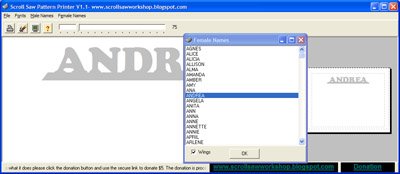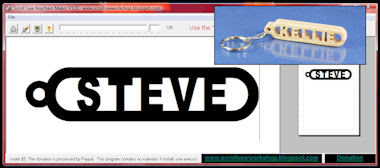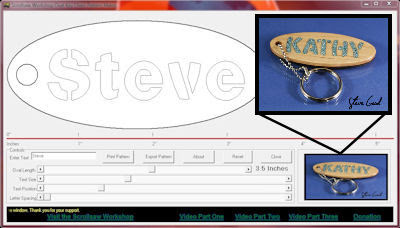-
Here is a treat for you guys. I want to introduce you to Dave Kettunen. Dave is a scroll saw artist who enjoys just a bit of a challenge. In this post Dave gives a run down of what it takes to build the York Minster Clock. The pattern for this clock is available here Wildwood Designs.
Thanks Dave for the wonderful look into your shop.
The images are of the York Minster laid out on the floor of my work shop
(minus the floors of the clock) and the syringe with florist's clay for sealing
the needle. me at the saw, another of just my saw and red oak cut offs ready for
resawing and planning. I got a hell of a deal on red oak cut offs from a
local high school wood shop ($50 for a pickup bed filled). I use pine
runners to eliminate snipe waste from these short pieces. On most of my
clocks, if you don’t make your own boards, you probably won’t be able to afford
the wood to make these clocks. Also resawing allows me to “book” mark
boards for gluing to make wider boards.


This clock (York Minster in red oak) is the latest of the larger cathedral
style clocks that I’ve cut. The first being the Dome Clock with Base in
red oak; two Orleans Cathedral Clocks, one in cherry and one in black walnut;
Roman Cathedral in red oak and lastly The Chimes of Normandy in black
walnut. I have several copies made off all the plans I buy (local copier
shop). The original (marked as such) goes in a file and one of the copies
is cut up and scanned into my computer. I have a light table for taping
patterns larger than 8 1/2 x 11”. Since there are multiple pieces of the
same pattern number you don’t want to pay for all those copies. Also if
you make a boo boo on a piece, just bring the file up and print out
another. I know it’s a pain to do all this work, but believe me, it’s
worth it in the end. The second copy is used as a reference for
assembly.

I have three plans for intricate scrolling (York Minster, Amiens and the
Shopiere) and of the three I decided to to the York Minster first (no special
reason). Here’s the specifics; about 16 hours to make all the boards (I
resaw and plane my own lumber), about 5 hours of drilling the holes, 143.2 hours
for all the scrolling, 103 Olson #3 Machine Speed Blades, 10 Olson #2 Machine
Speed Blades and 3 #1 blades (mfg. unknown). I don’t have an estimate on
gluing the pattern to the wood nor removing the paper afterwards. Because
of the length of time between putting the pattern on the wood, cutting and
removing the pattern I would NOT recommend putting the pattern on over painters
tape. The tape may not come off. Incase anyone wonders about the
cutting time, I have a resettable hour meter on my scroll saw (by the way it’s a
Hagner V22) so when the saw is powered up, the timer runs. Threading the
blade and blade changing are all part of scrolling and that time counts
also.

This plan calls for 450 pieces and 3,743 inside cuts. About 95% of
the clock is cut from 1/4” material with a few pieces 3/16”, 1/8” and
-
3/32”. There’s 16 Pinnacles cut from 1/2” and the cuts are double
sided. There is a lot of repetitious cutting (up to 16 identical pieces)
so be prepared to get bored when tackling these. You will need a router
(in a table with a fence) and a 90 degree bit to route the face grooves in a
number of pieces (there’s no other way to do this). I also used this bit
to bevel the 90 degree angles where called for. There is beveling on some
of the 1/8” pieces so keep a close eye on your fingers when beveling these small
pieces. I try to precut all the pieces to width and length to save time
and fit up later but I still end up doing some trimming during fit up. I
used Elmers Carpenter Wood Glue thru out and found that a 12cc veterinary
syringe with a 16ga needle (tip filed flat) to be extremely helpful in applying
the glue. I also use silicone rubber bands to hold the smaller pieces
together while gluing. These bands will not stick to the glue squeeze
out. Finally when the assemble was completed (I don’t have a time for
assembly), I took it outside where I sprayed it with numerous coats of lacquer
using a detail spray gun. I still have to install the lighting yet.
On all future work I will be using a product called scrollers tape I get
from Scroller LTD. This is the next best thing since sliced bread.
It goes on easy, the pattern is applied/positioned to the wood and pressed
down. Saw and remove the pattern. The tape leaves no sticky residue
and you can leave the spray glue and mineral spirits in the can. The tape
is somewhat pricy but not breathing fumes is a lot more healthier. I used
this material on the thinner stock and had no problem with removal even on the
3/32” pieces.

This tape really shines when it comes to cutting puzzles when it’s time to
remove the pattern from the pieces. You don’t need a separate cover
sheet. I use 1/4” 5 ply underlayment, two coats of varnish sanded between
coats to seal the surface, apply the puzzle pattern with contact cement, spray
the pattern with several coats of clear lacquer and apply the scrollers tape and
grid and cut.
Here are a couple more clocks. The first one is The Dome Clock and the second is The
Chimes of Normandy Clock. Both are available from Wildwood Designs.
Yours,
Dave Kettunen





















































